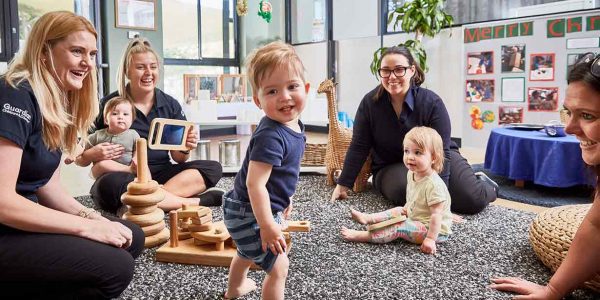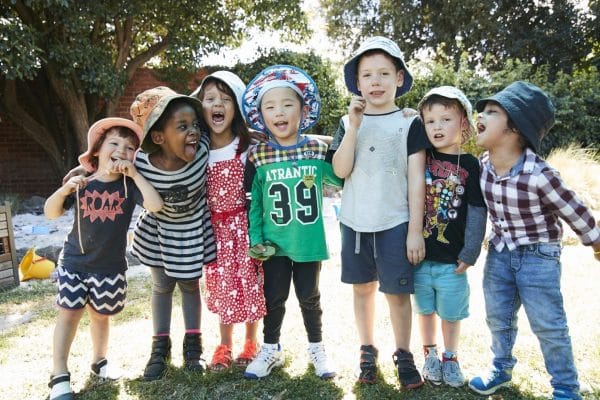Early Childhood Physical Health and Cognitive Development Guide

Developmental milestones are the essential abilities such as moving, seeing, hearing, communicating and interacting with other people. Babies are developing these skills from birth, and they gradually develop – at a rapid pace – during the first five years of life.
These skills are the foundations of how children will engage with the world. If you are worried about your baby’s progress and development, it’s worth discussing it with your doctor or maternal health nurse. They will be able to answer your questions.
The main areas that are considered key to your child’s development, are:
- Cognitive: Your child’s learning, their senses, and how they are engaging with the world around them.
- Physical: This includes large body movements, such as sitting and walking, and small body movements like controlling their hands, reflexes, vision and other physical requirements like sleeping and eating.
- Language: This includes hearing, making and understanding sounds in their environment.
- Social and Emotional: How your child reacts and bonds with the people around them.
There is more information on each of these areas of child development, below.

Cognitive development in children
Children are learning from birth – observing and gathering information about the people and the world around them. Babies are constantly discovering new things about themselves and where they fit. And while every child develops according to their own unique timeline, there are a number of common cognitive milestones that happen along the way.
Here we take a look at those cognitive development milestones in children, from birth for five years.
- 0-3 months. Developmental milestones at this age are all about the basic senses and babies learning more about their own body and their environment. This might look like focusing on moving objects or people, using facial expressions to respond to their environment or demonstrate anticipatory behaviors, like making sucking sounds at the site of a nipple or bottle.
- 3-6 months. At this age, babies begin to develop their perception which means they will begin to imitate facial expressions, react to familiar sounds, recognise familiar faces and respond to the facial expressions of others.
- 6-9 months. There is a lot of wonder at this age as babies will gaze at things like bubbles floating in the air. They can also tell the difference between real and fake objects – such as a real dog versus a toy dog.
- 9-12 months. As a baby becomes more physically capable, they are able to explore the world around them. This could include sitting up, crawling, even walking for some. At this stage children will enjoy looking at picture books, imitating basic movements like waving hello or goodbye, or blowing kisses, and even begin to move and manipulate objects like blocks.
- 1-2 years. From the age of one, children’s cognitive, physical and social development speeds up rapidly. They will spend a lot of time observing adults, and even imitate the actions and language that go with that – so mind yourself! At this age children can also tell the difference between themselves and others.
- 2-3 years. The age of independence begins. Children are now able to better explore the world, so much learning occurs due to real-world experiences. They will enjoy imitating adult actions like playing house or grocery shopping, and are able to respond to simple directions from caregivers. Their learning is coming along in leaps and bounds as they are able to match objects with their uses, name things in picture books and sort objects according to category or size.
- 3-4 years. The age of analysis. When observing, children at this age can begin to sort things into categories. They are also becoming very active learners, wanting to ask lots of questions and constantly enquire, “why?”. There concept of time is becoming more solid as they can understand things happening in the past or the present, and their attention span is continuing to grow.
- 4-5 years. Before starting school, most children will be getting better and better with their spoken language and can do a number of things needed for school readiness. This includes, but is not limited to: counting to five, drawing the basic shape of everyday objects, name and identify colours, rhyme and draw pictures that they can explain.
These are some of the most common cognitive milestones in children from birth to five years. But it’s important to remember that every child develops according to their own timeline. If you have any concerns about your child’s development, speak to your healthcare provider or family doctor.
Physical development in children
Physical development is the most obvious of the child development areas. You can literally see your child changing and growing before your very eyes. Parents – and others – readily notice things like height and weight changes, as well as the development of both fine motor and gross (large) motor skills.
Parents playing and bonding with their children is crucial to physical development. When they feel safe and secure, children are more easily able to explore and push themselves – as they do when engaging in ‘tricky play’. When your child rolls down a hill or slides down a slide, they are developing their senses and understanding their bodies. When they spin, hang upside down, run down a hill or climb a wall. When they balance, jump, skip, stand on one leg, roll, walk backward and sideways, over, under and through things. The list goes on!
For younger children, this ‘scaffolding’ process – whereby a parent or caregiver supports a child to develop their skills and abilities – might take a few different forms. Providing objects that encourage a baby to reach and grasp; holding the hands of a toddler while they take a few steps; helping your child to button or zip clothing; helping your child to ride a bike; or even a simple game of catch.
This development is about physicality, but also developing skills like resilience, confidence in themselves and their bodies, and reinforcing that they are capable and competent individuals.

Some of the key physical milestones for children at each age stage, include:
- 0-6 months. Lifts head and chest when on the stomach; rolls – side to side and from back to tummy; sits (with support); holds head up; can raise themselves on forearms; reaches and holds objects; plays with fingers hands and toes.
- 6-12 months. Sits without support; crawls; pulls to standing; walks with help; develops hand-eye coordination; reaches for smaller objects; places objects in a container; points with fingers.
- 12-18 months. Stands alone; walks without support; runs; climbs; can throw a ball; turns multiple pages of a book; uses thumb and forefinger to pick up small objects; can open a box; holds a spoon with a first; drinks from a cup.
- 18 months – 2 years. Jumps; bends at waist to pick up objects; kicks a ball; balances on a beam; walks upstairs; enjoys riding toys; beginning to draw; turns doorknobs; pulls zippers; shows hand preferences; drinks from a straw.
- 2-3 years. Constantly moving; runs but finds it hard to stop; throws ball overhand; can balance on one foot; can walk backwards; jumps ff low objects; turns individual pages of a book; screws lids on and off; builds towers; scribbles circles and lines; uses spoon; strings beads; holds scissors.
- 3-4 years. Hops, skips, jumps and runs; walks on tiptoes; marches to a rhythm; uses a swing; rides a tricycle; alternate steps when climbing stairs; holds pencil with control; draws straight lines; cuts with scissors; uses spoon and fork; draws a three-part person.
- 4-5 years. Turns somersaults and hangs on bars; hops several times in a row; climbs large play equipment; jumps up and down; bounces a ball and catches it with both hands; draws a house and person; prints name; brushes teeth, combs hair and washes hands; dresses self except for tying shoes.
This is by no means a complete list of the gross and fine motor skills children will develop over the first five years. But it provides a good overview for what you can expect and see from your child as they develop in leaps and bounds!
Language development in children
Language development is key to a number of other developmental areas – such as cognitive, social and literacy. It is a key developmental area that is the backbone for your child’s ability to communicate, which encapsulates expressing their feelings, thinking, learning, problem solving and developing and maintaining relationships.
Children usually achieve three important language milestones in the first two years of life:
- Understanding words spoken by their parents (6-9 months)
- Saying their first words (12-18 months)
- Combining 2-3 words in simple sentences (2 years)
Around the age of five or six, when Australian children start primary school, they can communicate easily with both peers and adults.
How to support language development in your child
Some simple everyday things you can do to help your child develop a rich love of language, include:
- Read books aloud together from when your child is a baby. This is not only an incredible bonding opportunity, it also allows you to point to word as you say them and help your child establish those early connections around meaning and symbols.
- Talk with your child and use many different words in different contexts to help them build their understanding and vocabulary.
- Build on what your child says. For example, if your child says “truck”, you can ask, “Did you see the big blue truck?”
- Visit the local library and borrow a new book regularly. This will help instill in your child a love of reading as it’s associated with a fun activity.
Social and Emotional development in children
The first five years are fundamental in the development of every child. It is during this foundational time that children leap and bound ahead when it comes to their motor, communication and language, cognitive, and social and emotional skills.
Of particular importance when considering the transition to formal schooling, is the social and emotional elements of this equation. This is all about how a child begins to understand who they are, what they are feeling (and why), and what to expect when interacting with others.

During this time, children are beginning to:
- Initiate and maintain relationships
- Feel, express and manage their emotions
- Explore their environment with increasing curiosity.
Positive social and emotional development is crucial during this period for a number of reasons. Understanding who they are and their place in the world has a direct link to a child’s:
- Self-confidence
- Empathy
- Resilience
- Friendships.
This type of development also has an impact of their ability to develop in other key areas which are important when it comes to success inside and outside the classroom, including academic outcomes. In fact, strong national and international research shows the biggest determinants of academic achievement for a positive transition to school, and for later success at school and in life, are that young children need to be socially and emotionally ready.
Looking for the right Childcare Centre for your Family?
Submit your details and a member of our Concierge Team will be in touch to discuss what you need and how we can help you experience something more than childcare.
We'll be in touch soon.






